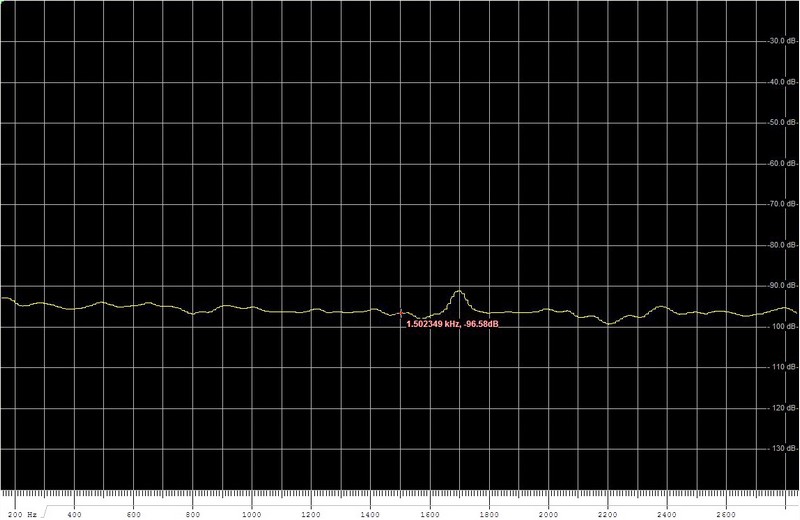Digital operating modes are becoming more and more interesting for radio amateurs. The installation and use of the software, mostly Open Source, is easy. But have you ever checked one of the most important parts in the chain of your digital mode “the sound card?”
There is a free and very powerful tool available, written by DL4YHF, it is the DL4YHF’s Audio Spectrum Analyser.
Spectrum Lab in action, connected to the output of an microphone amplifier

Don’t let yourself be drowned by the immense options and functions of the software. We want to check the basic noise floor of our sound card, to compare and making decisions.
Go to your windows sound card settings, check that there is no extra amplification activated, click on the speaker symbol with your right mouse button, select “db” instead of steps (?) and set the level to “0db” level. Most sound cards offer all kind of options, like “surround” and Dolby etc. For digital modes in HamRadio – this has to be set to “OFF”!
Download and install “DL4YHF’s Audio Spectrum Analyser”. Start it and go to “File”, click on “Load Settings From…” and load the unzipped “noisefloor.usr”. This file can be downloaded here: noisefloor.zip. It is just a ready made settings file for Spectrum Lab.
IMPORTANT: the sound card to be checked must be connected to your PC before you start Spectrum Lab, either without cables or absolute no signal input from your RX. You can check this in two different ways: sound card
connected, RX muted, or sound card connected, RX without any antenna connected.
Just in case, you want to check the settings in Spectrum Lab:
Go to (top menu) “Options”, [1] “Audio Settings I/O device selection” and select your sound card and sampling rate [2] Go to (top menu) “Options”, click on the down arrow [2] and select your sound card to be tested and set the sampling rate. Go to (top menu) ‘Options’, select “…part 2: Ampl-Range…” [3] click on it and in [4] set your desired range to be displayed.

To give you some info and see what I discovered
The famous “SignaLink USB” sound card. Does not need any power supply, power is retrieved by the USB port. And this could be disastrous. Did you ever check your +5Volt about hum? Look what I saw on my Signalink

A perfect 50 Hz hum and the basic noise level is around -70db. OK, OK, SignaLink design is of 2001, so in fact it is a very old design. Several web pages giving you infos how to ‘mod’ the SignaLink for surpressing the 50Hz / 60Hz hum of the +5V. Apparently at my setup, my 7 port USB hub works perfect for all kind of sticks and devices, but the 50Hz of the +5 Volt is creeping into the SignaLink.
Next, I pulled out several ‘USB sound card dongles of my junk box, collected over the years

Well, a little bit better, basic noise floor is around -90db

Sabrent-au-emac (picture above) is even better, basic noise floor is around -120db. And it costs only 8,- Euro!
And then I grabbed my, not so cheap, ‘Audiophile Performance’ Sound Blaster X-Fi HD SB1240 USB sound card

Wow, a -125db at 1500Hz basic noise level. What a difference! At least 60db improvement (!) over the worst and 40db better than the USB Dongle Sound Cards.
But, I have a sound card in my TS-990, an expensive toy, let’s see what we got. Settings: USB-D1 (upper sideband, data), no antenna connected, audio “MUTE” is “ON”, input from internal TS-990 sound card via USB

Not bad, but not amazing either. Just ~7db better than one of the “no-name” USB Sound Card Dongle? There is a constant “hump” at 1700Hz, could not find out, why this can be seen all the time. Not nice at all 🙁
So, with some mixed feelings I selected my new “micro KEYER III”. Let’s see what we have on a Kenwood TS-990. Settings: USB-D1 (upper sideband, data), no antenna connected, audio “MUTE” is “ON”, input at ACC2

Not bad, what the guys at microHAM have developed in the micro KEYER III
The MKIII is even a tick better and more linear than the highly praised Sound Blaster SB1240 🙂
Next settings: USB-D1 (upper sideband, data), no antenna connected, audio in ‘MUTE’ is ‘OFF’, micro KEYER III input at ACC2. In this case we have the receiver noise at the input of the MKIII, but no antenna connected

So we realize, the TS-990 will lift the noise level to – 100db, we loose 25db due to mixer and audio in the TS-990
The next step I tried: USB-D1 (upper sideband, data), antenna connected, micro KEYER III input at ACC2. and tuned to the FT8 QRG on 20m on a late afternoon in November 2018, QTH located in the urban area of Vienna / Austria.

The conclusion: check your sound card, you will be surprised!
All the information in this article are from Wolfgang Meister, OE1MWW. Thank you Wolfgang, great job 🙂
You can find the original article on the following website http://members.chello.at/oe1mww/sound-card-check/
